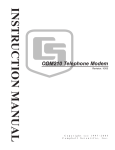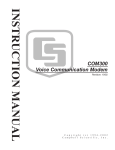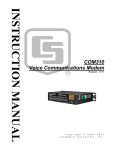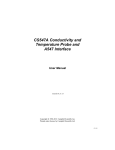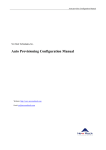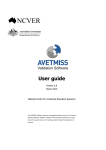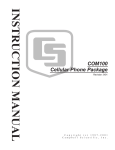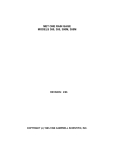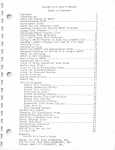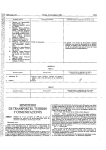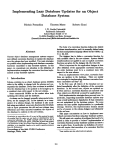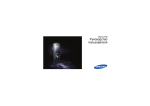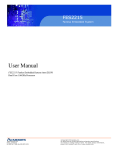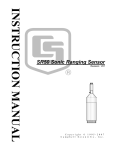Download Campbell COM200 Instruction manual
Transcript
COM200 TELEPHONE MODEM INSTRUCTION MANUAL REVISION: 5/01 COPYRIGHT (c) 1997-2001 CAMPBELL SCIENTIFIC, INC. This is a blank page. Warranty and Assistance The COM200 TELEPHONE MODEM is warranted by CAMPBELL SCIENTIFIC, INC. to be free from defects in materials and workmanship under normal use and service for twelve (12) months from date of shipment unless specified otherwise. Batteries have no warranty. CAMPBELL SCIENTIFIC, INC.'s obligation under this warranty is limited to repairing or replacing (at CAMPBELL SCIENTIFIC, INC.'s option) defective products. The customer shall assume all costs of removing, reinstalling, and shipping defective products to CAMPBELL SCIENTIFIC, INC. CAMPBELL SCIENTIFIC, INC. will return such products by surface carrier prepaid. This warranty shall not apply to any CAMPBELL SCIENTIFIC, INC. products which have been subjected to modification, misuse, neglect, accidents of nature, or shipping damage. This warranty is in lieu of all other warranties, expressed or implied, including warranties of merchantability or fitness for a particular purpose. CAMPBELL SCIENTIFIC, INC. is not liable for special, indirect, incidental, or consequential damages. Products may not be returned without prior authorization. To obtain a Returned Materials Authorization (RMA), contact CAMPBELL SCIENTIFIC, INC., phone (435) 753-2342. After an applications engineer determines the nature of the problem, an RMA number will be issued. Please write this number clearly on the outside of the shipping container. CAMPBELL SCIENTIFIC's shipping address is: CAMPBELL SCIENTIFIC, INC. RMA#_____ 815 West 1800 North Logan, Utah 84321-1784 CAMPBELL SCIENTIFIC, INC. does not accept collect calls. Non-warranty products returned for repair should be accompanied by a purchase order to cover the repair. 815 W. 1800 N. Logan, UT 84321-1784 USA Phone (435) 753-2342 FAX (435) 750-9540 www.campbellsci.com Campbell Scientific Canada Corp. 11564 -149th Street Edmonton, Alberta T5M 1W7 CANADA Phone (780) 454-2505 FAX (780) 454-2655 Campbell Scientific Ltd. Campbell Park 80 Hathern Road Shepshed, Loughborough LE12 9GX, U.K. Phone +44 (0) 1509 601141 FAX +44 (0) 1509 601091 This is a blank page. COM200 Telephone Modem Table of Contents 1. Introduction ................................................................ 1 1.1 General Description ................................................................................. 1 1.2 Computer Requirements........................................................................... 1 2. Specifications............................................................. 1 3. Installation .................................................................. 2 3.1 3.2 3.3 3.4 Connecting to Datalogger ........................................................................ 2 Connecting to Earth Ground .................................................................... 3 Telephone to MD9 or Telephone to RF Systems ..................................... 3 Telephone Service.................................................................................... 3 4. Troubleshooting......................................................... 6 5. Modem Settings in Non-Volatile Memory ................. 7 Appendixes A. Modifying the Non-Volatile Memory...................... A-1 A.1 Hardware Connection to COM200...................................................... A-1 A.2 Remote Communication to the COM200............................................ A-1 A.3 Hayes at Command Summary............................................................. A-3 B. CS I/O Connection .................................................. B-1 B.1 CS I/O 9 Pin Connection ..................................................................... B-1 C. Theory of Operation ...............................................C-1 C.1 Theory of Operation ............................................................................ C-1 D. FCC Warning to Users of Class A Computing Devices .............................D-1 E. IC Information ......................................................... E-1 F. The 10704 12 V Adaptor.......................................... F-1 i COM200 Telephone Modem Table of Contents List of Figures 1 COM200...................................................................................................... 2 2 CR10X with CR10X Wiring Panel and COM200 Using Remote Telephone Line .................................................................................. 4 3 CR10X with CR10 Wiring Panel and COM200 Using RJ11C Telephone Jack .................................................................................... 5 A-1 CR10X with CR10 Wiring Panel and the old COM200 Using RJ11C Telephone Jack ................................................................................A-2 A-2 COM200 to Computer Connection .....................................................A-2 B-1 CS I/O Pin Out..................................................................................... B-1 List of Tables 1 Dataloggers that Require Direct 12 VDC Connection to COM200 ............ 3 F-1 Dataloggers that Require Direct 12 VDC Connection to COM200 ..... F-1 ii COM200 Telephone Modem 1. Introduction 1.1 General Description The COM200 Modem is a 9600/1200 baud modem employing the Hayes AT command set. Its primary use is as a remote site modem connected to a CSI datalogger. The modem is powered and enabled by the battery-powered datalogger. When not active, the COM200 draws less than 120 µA from the datalogger’s 12 VDC output. The COM200 is connected to a CSI datalogger by using a 9-pin subminiature D connector cable. This is the same 9-pin CS I/O connection common to all Campbell Scientific products. This is not an RS-232 connection. Appendix B describes the configuration of this connector. The COM200 can be used as an originate modem at the datalogger site. To originate a call to the computer, the datalogger is programmed using Instruction 97. Instruction 97 is described in detail in the datalogger manual. 1.2 Computer Requirements A Hayes compatible modem is used at the computer site with Campbell Scientific computer software to call the datalogger attached to the COM200. The computer’s modem must be configured to the proper settings using the modem initialization strings listed in the software programs. To communicate at 9600 baud, the calling modem’s error correction must be enabled. If your modem initialization string has an &Q0, you will need to change it to an &Q5 in order to enable the error correction. You must continue to use your old string for any communication at 1200 baud. 2. Specifications • Bell 212A, CCITT V.22, and CCITT V.32 compatible • Full duplex at 9600 and 1200 baud to datalogger • V.42 LAPM and MNP2-4 error correction • Hayes AT command set • RJ-11C telephone jack • FCC and IC (formally known as DOC) approval • Pulse or tone dialing 1 COM200 Telephone Modem CAMPBELL SCIENTIFIC INC. • Current drain: 120 µA quiescent, 140 mA active • Direct connection to and powered by CSI dataloggers • Supply requirements: 12 VDC regulated power supply • Internally switches 12 VDC external power minimizing current drain • Logic levels: below 1.5 V inputs a low state and above 3.5 V inputs a high state. A low voltage level on the TX data input (pin 9) and RX data output (pin 4) represents a mark • Operational temperature: -25oC to +50oC • Size: 5.2” x 1.7” x 3.6” // 13.1 x 4.3 x 9.2 cm • Weight: 0.75 lbs // 0.34 kg COM200 MO DE M Complies with Part 68 , FCC rules Ringer Eq uivalence . FCC Re gistration No 0.6B.Requ ired Conn . B9 This equip QUSA-3140 ector USOC 2-MM-T computin ment complies wi RJ11C. Ca g nadian Lo th unaccept device. Operation the requirements ad No. 5 ab whatever le interference of this equipmen in Part 15 of FCC t in a resid Ru to steps ar ential area les for Class A e necess radio and TV re ception ary to co S/N m ay cause requiring rrect the the oper interfere ator to ta nce. ke G 12V GND IN USA TIP MADE RING 1002 FIGURE 1. COM200 3. Installation The COM200 is designed to be used with standard analog telephone lines. It will not work with a digital telephone line. Connection to telephone companyprovided coin service (central office implemented systems) is prohibited. Connection to party line service is subject to state tariffs. 3.1 Connecting to Datalogger Connect the cable from the telephone RJ11C jack to the modem as shown in Figure 3. If the telephone company has not installed surge protection in the telephone line (no RJ11C jack), one must install surge protection (Model 6362 or 2372-01) and connect the ring and tip terminal blocks as shown in Figure 2. Current Campbell Scientific dataloggers provide 12 VDC to the COM200 via the SC12 cable (Figure 2). Older dataloggers do not provide 12 VDC on the datalogger's CS I/O 9 pin connector. When used with the older dataloggers listed in Table1, 12 VDC and ground need to be connected via the green power connector on the side of the COM200 (see Figure 3). 2 COM200 Telephone Modem Table 1. Dataloggers that Require Direct 12 VDC Connection to COM200 CR10(X) w/ silver wiring panel CR10(X) w/ black CR10 wiring panel (P/N 8032) 21X(L)—serial number 13,442 or lower CR500serial number 1764 or lower CR7—700X serial number 2778 or lower BDR301 and BDR320 3.2 Connecting to Earth Ground Connect the green 14 awg grounding wire (provided with the COM200) to the grounding terminal (GND) on the COM200 and to the enclosure’s earth ground connection. If the site does not have a grounded enclosure, then connect the ground wire directly to an earth ground connection. The datalogger ground should also be tied to the earth ground. CAUTION The modem must be grounded for its transient protection to work. 3.3 Telephone to MD9 or Telephone to RF Systems Telephone to MD9 or telephone to radio systems can be utilized for communicating with multiple dataloggers through one telephone line. Nothing additional or special is required for the telephone part of the link. See the MD9 or RF Manuals for complete information on their special requirements. 3.4 Telephone Service The goal of the telephone company is to provide you with the best service it can. In order to do this, it may occasionally be necessary for them to make changes in their equipment, operations, or procedures. If you have any questions about your telephone line, such as how many pieces of equipment you can connect to it, the telephone company will provide this information upon request. If the telephone company requests information concerning the equipment which you have connected to your telephone line, the FCC registration number and the ringer equivalence number (REN) of the COM200 are listed on it’s label. Additional technical information from the FCC and IC on the COM200 is available in Appendix D and E, respectively. 3 COM200 Telephone Modem G 1 V 2 ogan,U L tah G 2 1 V P R E W O IN W S V 2 1C TR L 7 S E IF D 8 9 4 G G H 0 1 1 5 L A G H 2 1 W S V 2 1 6 L A G H L A G E 3 G A G G V 5 V 5 G SI/O C G XW 0 1 R C G N IR L E N A P EINU D A M A S S E IF D 1 2 3 L A G H G H 4 5 L A G H 2 1 G 6 M D S 3 L A G E 1 G A 2 E G 1 P G P 2 G C 8 7 C 6 C 5 C 4 C 3 C C 2 1 C G 2 V 1 V 2 1 EH T R A D N U O R G G N IR W LN E N A P . O C L E B P M A TIF N IE C S C . C IN COM2 MODEM 2C 1 C S able /N S 2 0 D N G G IN R This eq uipment complies with the req uirements in a Prt 5 1of C Fu Rles for la Css A computing device. p Oeration of this eq uipment in a residential area maycause unacceptable interference to radio and TVreception req uiring the operator to take whatev er steps are necessaryto correct the interference. TIP Cmplies with P o art 8 ,6F Crules. C Fe Rgistration N o. 9 T M 8 3 5 -7 A S U Q B inger E R uiv q alence 0 .A .5e Rq uired C onnector U CR O S . C 1 J EINS D A M A U lue =R B ing urial P B hone a Cble To a Erth G round Pone L h ine Transient P rotector odel 6 (M 2or 2 3 ) 1 -0 7 3 lue/W B hite =Tip FIGURE 2. CR10X with CR10X Wiring Panel and COM200 Using Remote Telephone Line 4 COM200 Telephone Modem IF D G A H L A G 4 8 E S 7 H L G A H L G A 5 6 9 0 1 1 2 1 3 A E G G G G G G G V 2 1 V 2 1 ITC W S D E H V 2 1 G 2 1 V P R E W O IN CAME SCIENTIFIC INC. CR1 EINU D A M A S G N IR W LN E N A P . O ITH W S D E C 1 2 1 H L A G E S IF D G A 3 H 2 4 5 L G A H 3 TH R A E 6 L A G 1 2 E E LI/O IA R E S G G 1 V 2 TR N O C L O G V 5 V 5 P 1 P 2 To a Erth round G 8 C C 7 C 6 C 5 C 4 C 3 C 2 ed R ) v 2 1 (+ 4A 1 G W round iW G re 1 C lack B round) (G 2C 1 C S able CAME SCIENTIF IC AUSTRAIA T. TD. G 12V COM2A 2 0 D N G R=0 N E .5 TIP M E D A INU A S G IN R /N S MODEM Telephone a Wl ack J FIGURE 3. CR10X with CR10 Wiring Panel and COM200 Using RJ11C Telephone Jack 5 COM200 Telephone Modem 4. Troubleshooting When the Campbell Scientific software cannot establish a link to the remote datalogger that is connected to the COM200, check the following: 1) Verify the modem initialization settings have been changed for the specific calling modem on the computer. See software manual and/or help screens for more information. 2) Verify nothing else is using the same COM port on the computer. Even if a program is minimized in windows, it may have a lock on the COM port. Some notebook computers do not automatically activate the COM ports. Verify the COM port you are using is activated. 3) The Campbell Scientific software will display an activity of communication as the link is being established. Assuming the above items are O.K., the software should display in the activity window/screen something such as “ ATDT#######” . Where the #### is the telephone number listed in the dialing path of the software for the datalogger you are trying to call. The local modem attached to the computer will respond back to the computer with result codes depending on how the call is progressing. These result codes can be either numeric (0, 1, 2, etc.) or “ verbose” (“ OK” , “ CONNECT” , “ RING” , etc.). Our software expects numeric result codes. The result codes may appear on a new line, be appended to the last line, or may even replace the first letter(s) of the last line. If these characters are verbose, the initialization string for the modem will need to be changed. Appendix A has a list of possible result codes. The result code returned may indicate why the call is unsuccessful. 6 4) Can you attach a normal analog telephone to the line and make a call out? If not, contact your local telephone company. If you can make a call out but the connection is poor or faint, contact your local telephone company. 5) Verify the COM200 is receiving 12 VDC. If the COM200 is receiving 12 VDC from a separate power supply instead of the datalogger, is the ground of the separate power supply connected to the datalogger’s ground? 6) Verify the COM200 is the only Modem Enable device connected to the datalogger. Other common Campbell Scientific modem enable devices are the SC32A, some RF modems, and the MD9. 7) Verify the datalogger is turned on. COM200 Telephone Modem To comply with FCC Rules and Regulations, all repairs on the COM200 modem must be performed by Campbell Scientific, Inc. or an authorized agent of Campbell Scientific, Inc. For assistance in installation, troubleshooting, or for repair, contact Campbell Scientific: Campbell Scientific, Inc. 815 West 1800 North Logan, Utah 84321-1784 Telephone: (435) 753-2342 Fax: (435) 750-9540 Web site: www.campbellsci.com 5. Modem Settings in Non-Volatile Memory The COM200 comes from the factory with the appropriate settings for most applications. It is programmed to answer the call as soon as it detects the call. One may modify the COM200’s settings in non-volatile memory using Hayes AT commands. Appendix A describes the procedures and commands required to make the changes described in this section. Some of the settings one may change are: Disable auto-answer: This option is used only when the modem is not to answer a call. For example, the COM200 is connected to a telephone line which is to be used part time for voice communication. In this situation it is best to have the datalogger call the computer. th Answer on X ring: This option is used when the modem is sharing a line and you only want it to answer after a specified number of rings. For example, the COM200 is sharing a line with people at an office. It can be programmed to th only answer after the 4 ring. When the people know the call is for the weather station, they will not pickup the telephone, and after 4 rings, the datalogger will pick it up. Change telephone system types: Change from the Bell 212A (U.S. and Canada) system to a CCITT V.32 (foreign, 9600 baud) or CCITT V.22 (foreign, 1200 baud) system. This does not mean that the COM200 is tested and approved for all foreign countries. CCITT is an international consultative committee that sets international communications usage standards. V.32 and V.22 are standards that the COM200 meets. 7 COM200 Telephone Modem This is a blank page. 8 Appendix A. Modifying the Non-Volatile Memory To modify the COM200’s settings, one must communicate directly to the COM200. This may be accomplished by using one of the two methods below. CAUTION Changing some of the modem's settings may result in communication problems. After changing the settings, try the modem locally before installing it at a remote location. A.1 Hardware Connection to COM200 Connect the COM200 to a computer using an SC532 interface (Figure A-1). COM200s prior to S/N 2334 require the 10704 adaptor as shown in Figure A2. The computer software (PC208W) used to communicate with the COM200 must set the RS232 RTS line low. rd For example, to change the COM200 to answer on the 3 ring, the following commands would be sent to the COM200 through the PC208W terminal emulator (RTS not active on modem hardware configuration): ATS0=3 AT&W0 A.2 Remote Communication to the COM200 To remotely communicate with the COM200, program the datalogger to initiate a call to it using a program similar to the Example Program 1.* After this program runs once, the modem is now programmed and the actual program one wants to run may now be downloaded to the datalogger. *Please note that this program requires that the option code for an RF modem be used instead of the normal phone modem option. A-1 Appendix A. Modifying the Non-Volatile Memory A C2 A AC A A o o ed lac CA CC C. C Cable C Complies ith inger uiale art , CC rules. CC egist nce ..euired ration o. A Connecto r C C. Cana his euipmen dian oad o. computin t complies ith the g unaccep deice. peration of reuirements in art tabl hateer step e interference this euepment in of CC ules for Clas a residentia to radio sA s are nec and l area may essary to rece cause correct the ption reuiring the operato interferenc r to tae e. A A FIGURE A-1. COM200 to Computer Connection A C2 A AC A A o o lac ed CA CC C. C Cable C Complies ith inger uialenc art , CC rules. CC egis e ..euired tration o. A Connector C C. Canadia his euipmen n oad o. computing t complies ith the unaccepta deice. peration of reuirements in art hateer ste ble interference this euepment in of CC ules for Cla a residen to radio ss A ps are nec and tial area essary to reception may cau correct se the interfer reuiring the ope rator to tae ence. A A Adaptor FIGURE A-2. CR10X with CR10 Wiring Panel and the old COM200 A-2 Appendix A. Modifying the Non-Volatile Memory Example Program 1 *Table 1 Program 01: 1 Execution Interval (seconds) 1: Initiate Telecommunications (P97) 1: 02 RF Modem/9600 Baud 2: 1 Disabled when User Flag 1 is High 3: 20 Seconds Call Time Limit 4: 0 Seconds Before Fast Retry 5: 0 Fast Retries 6: 0 Minutes before Slow Retry 7: 1 Failures Loc [ Failure ] 8: 0 Data Logger ID 2: Extended Parameters (P63) 1: 65 Option ;A 2: 84 Option ;T 3: 83 Option ;S 4: 48 Option ;0 5: 61 Option ;= 6: 51 Option ;3 7: 38 Option ;& 8: 87 Option ;W 3: Extended Parameters (P63) 1: 48 Option ;0 2: 68 Option ;D 3: 84 Option ;T 4: 13 Option 5: 00 Option 6: 00 Option 7: 00 Option 8: 00 Option A.3 Hayes AT Command Summary This manual does not attempt to be a primer on the Hayes AT command set. The commands are, therefore, only summarized below. For most applications, these commands will not need to be used. Except as noted, all commands should begin with an “ AT” and end with a carriage return (hit the [Enter] key). There are no “ O” as in Oscar commands, only “ 0” as in Zero commands. All commands must be issued as CAPITAL letters. A-3 Appendix A. Modifying the Non-Volatile Memory COMMANDS TO CHANGE DEFAULT MODES: B1 (default) B0 CCITT V.32 (9600 baud), Bell 212A (1200 baud), and Bell 103 (300 baud) CCITT V.32 (9600 baud), CCITT V.22 (1200 baud), and CCITT V.21 (300 baud) S0=0 S0=1 S0=2 S0=X Disable Auto Answer Answer on first ring Answer on second ring th Answer on X ring. (X is a number; maximum number = 4) &F &W0 &V Restore factory defaults Store current profile as Profile to load on power up Display the current profile to the screen RESULT CODES: 0 1 2 3 4 5 6 7 8 12 13 17 CAUTION A-4 OK Connect Ring No Carrier Error Connect 1200 Baud No Dial Tone Busy No Answer Connect 9600 Baud Connect 9600/14400 Baud Connect 9600 Baud If more than four rings are specified, the datalogger may time out before the modem answers; communication will never be established! It is possible in some conditions to allow more than four rings. Consult a Campbell Scientific applications engineer about optimizing modem negotiations before trying this and be sure to try the set up locally before installing at a remote location. Appendix B. CS I/O Connection B.1 CS I/O 9-Pin Connection The pin out of the connector is shown in Figure B-1. The direction of the signal relative to the modem is shown in parenthesis. Unless specified otherwise, all levels are 0 V for logic low, 5 V for logic high. FIGURE B-1. CS I/O Pin Out 1. (input) +5 VDC supply. Not used by COM200. 2. (input) Ground 3. (output) Ring - a logic high signifies a ring signal has been detected 4. (output) RX Data - serial data from COM200 5. (input) Modem Enable - a logic high internally switches power to the modem. A logic low internally shuts off power to the modem. 6. (input) Serial Device Enable - a logic high disables communication with the modem without removing power or changing the modem's mode. 7. (input) SDC clock. Not used by COM200. 8. (input) +12 VDC supply 9. (input) TX Data - serial data to COM200 B-1 This is a blank page. Appendix C. Theory of Operation C.1 Theory of Operation The COM200 modem is used to transmit data over bandwidth-limited channels such as telephone lines by modulating audio tones, using Phase Shift Keying (PSK) at 9600 or 1200 baud and Frequency Shift Keying (FSK) at 300 baud. The telephone company gives a 40 to 150 VRMS, 20 Hz signal on the telephone lines to signify a ring, which is typically on for 2 seconds and off for 4 seconds. The ring detection circuitry is continuously powered but draws less than 2 µA. The ring signal is passed on to the datalogger through an optocoupler. The datalogger responds by raising the Modem Enable line which internally switches the 12 VDC power to the modem. The modem then answers and remains off-hook until it loses the carrier or the datalogger lowers the Modem Enable line. The datalogger lowers the Modem Enable line by remote command or after 40 seconds in the absence of a command. When the Modem Enable line goes low, it internally removes the 12 VDC power from the modem circuitry, dropping power to the off-hook relay and thus placing the telephone line on-hook. To reject noise common to both telephone lines and to satisfy registration requirements, the modem circuitry is electrically isolated from the telephone lines by using an opto-isolator and coupling transformer. C-1 This is a blank page. Appendix D. FCC Warning to Users of Class A Computing Devices WARNING This equipment generates, uses, and can radiate radio frequency energy, and if not installed and used in accordance with the instruction manual, may cause interference to radio communications. It has been tested and found to comply with the limits for a Class A computing device pursuant to Subpart J of Part 15 of FCC Rules, which are designed to provide reasonable protection against such interference when operated in a COMMERCIAL ENVIRONMENT. Operation of this equipment in a residential area may cause interference to radio and television reception. The operator must take whatever measures are necessary to correct the interference. D-1 This is a blank page. Appendix E. IC Information NOTE Industry Canada (IC) was formally known as DOC. CP-01, Issue 8, Part I Section 14.1 “ NOTICE: The Industry Canada label identifies certified equipment. This certification means that the equipment meets certain telecommunications network protective, operational and safety requirements as prescribed in the appropriate Terminal Equipment Technical Requirements document(s). The Department does not guarantee the equipment will operate to the user’s satisfaction. “ Before installing this equipment, users should ensure that it is permissible to be connected to the facilities of the local telecommunications company. The equipment must also be installed using an acceptable method of connection. The customer should be aware that compliance with the above conditions may not prevent degradation of service in some situations. “ Repairs to certified equipment should be coordinated by a representative designated by the supplier. Any repairs or alterations made by the user to this equipment, or equipment malfunctions, may give the telecommunications company cause to request the user to disconnect the equipment. “ Users should ensure for their own protection that the electrical ground connections of the power utility, telephone lines and internal metallic water pipe system, if present, are connected together. This precaution may be particularly important in rural areas. CAUTION Users should not attempt to make such connections themselves, but should contact the appropriate electric inspection authority, or electrician, as appropriate.” CP-01, Issue 8, Part I Section 14.2 “ NOTICE: The Ringer Equivalence Number (REN) assigned to each terminal device provides an indication of the maximum number of terminals allowed to be connected to a telephone interface. The termination on an interface may consist of any combination of devices subject only to the requirement that the sum of the Ringer Equivalence Numbers of all the devices does not exceed 5.” E-1 This is a blank page. Appendix F. The 10704 12 V Adaptor COM200s prior to serial number 2334 require a part number 10704 adaptor to connect 12 volts directly to the modem. The 10704 adaptor is used between the SC12 cable and the datalogger (Figure F-1). Table F-1 lists the Campbell Scientific dataloggers that do not supply 12 VDC on the 9 pin connector and hence require a direct 12 VDC connection to the COM200. When using the 10704 adaptor, the red and black wires should be connected to 12 V and Ground, respectively. The female connector of the 10704 should be connected to the COM200 while the male connector goes to the datalogger. Table F-1. Dataloggers that Require Direct 12 VDC Connection to COM200 CR10(X) w/ silver wiring panel CR10(X) w/ black CR10 wiring panel (P/N 8032) 21X(L)—serial number 13,442 or lower CR500serial number 1764 or lower CR7—700X serial number 2778 or lower BDR301 and BDR320 DIFF SE AG H L AG H L AG H L AG E3 AG G G 4 5 6 7 8 9 10 11 12 DIFF 12V 12V SWITCHED 12V G 12V POWER IN SERIAL I/O 1 F SE G G G G MADE IN USA WIRING PANEL NO. SWITCHED 12V 1 2 3 4 5 6 CONTROL EARTH 1 2 3 G 5V 5V P1 P2 C8 C7 C6 C5 C4 C3 C2 C1 AG H L AG H L AG H L AG E1 E2 G G To Earth Ground Red (+12v) Black (Ground) 14 AWG Ground Wire SC12 Cable CAMPBELL SCIENTIFIC INC. COM200 MOD EM Complies with Ringer Equiva Part 68, FCC rules. FCC Registr lence 0.6B.R ation No. equired Conne B9QUSA-7537 This equipm ctor USOC 8-MM-T RJ11C. Canad computing ent complies with ian Load No. unacceptabdevice. Operation the requirement 5 s whatever le interference of this equepment in Part 15 of FCC Rules for to radio steps are in a reside and TV Class ntial area necessary reception S/N may cause A to corre ct the interf requiring the operator erence. to take TIP IN USA RING MADE GND 1002 10704 Adaptor Telephone Wall Jack FIGURE F-1. CR10X with CR10 Wiring Panel and COM200 Using RJ11C Telephone Jack F-1 This is a blank page.




























